Raijū – Part II
Posted by: Loren Coleman on September 8th, 2009
The Raijū – Part II
by Brent Swancer
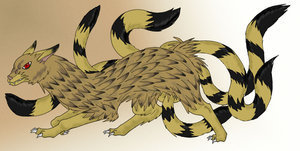
In Part I of this series, we learned about this unique thunder beast and ended wondering what sort of flesh and blood animals such a seemingly fantastical creature could possibly be. Let’s take a look at some of the possibilities and dig deeper into the potential biological origins of this creature of Japanese folklore.
The physical description and disposition of the Raijū seems to fit in very well with something perhaps from the Mustelidae family of mammals. This family encompasses a wide range of carnivores, including badgers, weasels, wolverines, and otters. The Raijū accounts tell of something that seems very much like a mustelid in appearance, often describing them as badger or weasel like. Mustelids are also known for their sharp teeth and claws, much like the Raijū. On wolverines or a burrowing mustelid such as the badger, the claws are especially quite pronounced, and such claws would also make sense for a tree dwelling animal like the Raijū for use in climbing. The general fierce disposition and aggressive temperament of some mustelids also fits in well with what is reported with Raijū.
Two species of mustelid found in Japan stand out in particular as good candidates: the Japanese marten and the Japanese sable.

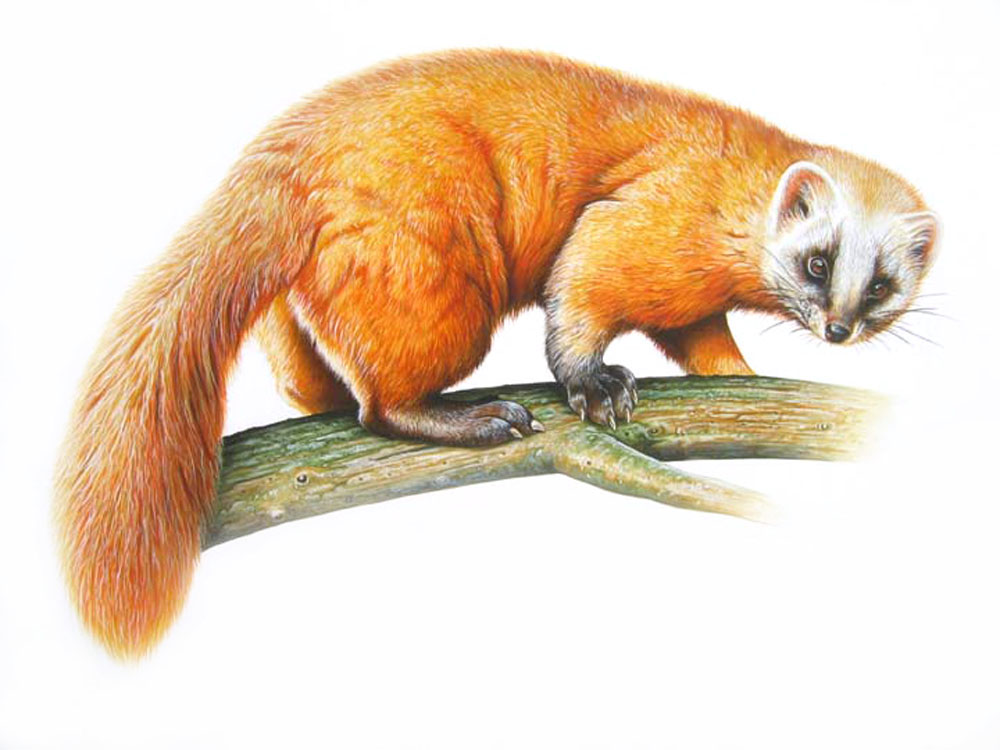
The Japanese marten (Martes melampus), is found throughout the southern islands of the Japanese archipelago, from Honshu to Kyushu, and have also been introduced to the northern island of Hokkaido. Males are around 45 to 49 cm (18~ 20 inches) long, and females 41 to 43 cm (16 ~ 17 inches), with an additional 17 to 20 cm (6.5 ~ 8 inches) added by the long tail. Martens look very much like weasels, only larger and with a sturdier build. These animals are arboreal (tree dwelling), highly agile, and good climbers, which fits in well with the Raijū’s reputed fondness for trees and ability to jump between them.
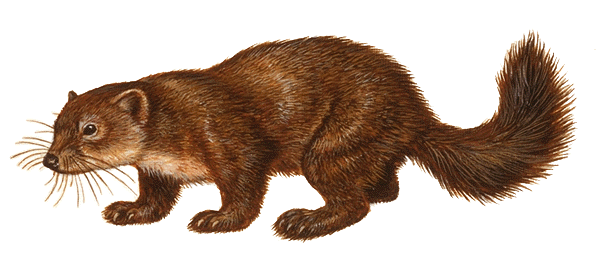
Another generally arboreal mustelid that seems to fit descriptions of the Raijū is the Japanese sable (Martes zebellina brachyurus), which is closely related to the marten. These animals are around 38~56 cm (15~ 22 inches) long for males and 35~51 cm (14~ 20 inches) for females. They have somewhat long, bushy tails, ranging from 9~12 cm (3.5~ 5 inches), that are used for balance when climbing. The sable has had a reputation in Japan for being particularly bad tempered and aggressive, which could help account for the Raijū’s purported viciousness. Although the sable’s range is restricted to the northern island of Hokkaido, perhaps they were once found farther south as well. There may have even possibly been a new subspecies of sable endemic to southern Japan.



The Japanese badger (Meles anakuma) is shown above in the three images.
Badgers, another mustelid, are also found in Japan, however several factors tend to argue against this creature as a possible explanation for Raijū in general. Badgers are a terrestrial animal that burrows rather than climbing trees like the apparently arboreal Raijū. In addition, badgers have already long been firmly entrenched in folklore, and therefore it would be unlikely that anyone would mistake one for a completely different entity altogether. The reputation of the badger as one of the most notorious tricksters in Japanese folklore also means that it is perhaps unlikely that anyone would attempt to capture one and keep it around in a cage.
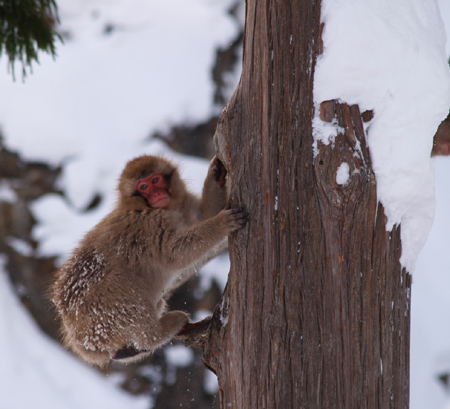
Or is the Raijū based on a type of primate? The only species of primate found naturally in Japan is the Japanese macaque (Macaca fuscata) which are found throughout the archipelago, except the northern island of Hokkaido. These macaques are semi arboreal, spending about equal amounts of time on the ground and in trees. They are also known to leap quite well and could be responsible for the shrieking sounds sometimes associated with Raijū, which were also occasionally described as looking like a monkey. It’s possible that macaques, or even an unknown species of primate could have been the basis of Raijū tales, however, the majority of descriptions give a weasel or badger like appearance that seems more consistent with a mustelid.
Known animal behavior seems to parallel some of that displayed in Raijū lore. Tales of Raijū leaping from tree to tree match up well with the sort of behavior exhibited by an arboreal predator such as the marten and sable, or a creature like the macaque. It is also quite possible that the storms with which Raijū are associated could further agitate some animals and even cause them to panic. Many animals are able to sense changes in barometric pressure, ozone concentrations, and humidity before a storm, and can demonstrate a wide range of behaviors in response, including increased uneasiness or agitation. There is also the additional element of booming thunder and lightning, which can cause a fear response in some animals, as anyone who has owned dogs can surely attest to. It seems plausible that storm conditions such as these could on occasion cause an arboreal animal to panic, dash about, leap from tree to tree, or otherwise show signs of the increased state of agitation present in Raijū accounts during foul weather.
The same fearful reactions may explain the keyed up behavior of the alleged captured Raijū, during bouts of bad weather. An animal captive in a cage or any enclosed, restricted space could feasibly become quite distressed under storm conditions. For instance, some of the fear responses for domestic animals can include hiding, uneasiness, trembling or shaking, a strong flight response or drive to escape, or outright panic. It is perhaps not too hard to imagine that the cases of captive Raijū displaying this sort of behavior, such as agitation, hair standing on end, and clawing at their cage, could have had something to do with a similar fear response due to storms. For an animal already strongly associated with storms, people would naturally assume it was due to the animals somehow being powered up by the thunder and lightning.
The refusal to eat so often mentioned with captive Raijū is also not unheard of with wild animals forced into captivity. This is a challenge often faced with some species that are hard to keep, and indeed some can even die from this, much like what was reported with captured Raijū. Even the flickering eyes reported in the case of the Raijū captured in the well in Izumo could be explained in terms of a flesh and blood animal, as the perceived flashing might have been caused by eye shine brought upon by the lightning or some other light source.
In light of this information, it seems at least worth considering that the Raijū legend could possibly have its basis in some type of arboreal mustelid or a creature very much like one, exhibiting known animal behaviors. Perhaps these very real animals at some point became entwined with the Japanese perceptions of storms and lightning, and thus were inextricably linked with lore concerning these weather phenomena.
If we are indeed dealing with a real animal, were these creatures a currently known extant species, an extinct species, or something undocumented? It is difficult to say as there is practically no representation of Raijū in modern reports. This may mean that modern understanding of animals and storms has caused a rift between what is known as real and what is known as pure folklore. The increasing understanding of how our world works can cause superstition and folklore to become regulated from something once seen as very literally real, to the world of myth. With the Raijū, what was once thought of as a servant of the god of thunder may now be recognized as a known, mundane animal, and so the folklore perhaps simply did not carry over into the modern day as reality. In essence, a mustelid or macaque is now known to be just that, and so reports of Raijū might have died along with widespread belief in such magical beliefs as servants of the thunder god mounted atop lighting bolts.
In that sense, perhaps now when someone sees for instance a Japanese marten, they are more likely to see that animal for what it is, without the accompanying folklore and magical powers surrounding it. A good example of this shifting status is the Japanese fox, which was once seen as a very mystical animal with many supernatural powers. In more ancient times, foxes would be described as doing all manner of magical things, and seeing one was hardly a mundane occurrence. Yet in modern times, a fox is seen as just a fox, and thus there are no longer reports of the more folkloric version of the fox. Many of the known animals once seen as magical are now perceived as more mundane. Has some similar transformation happened with perhaps the Japanese marten or sable?
Lack of modern day sightings could also mean that whatever the Raijū was is now extinct, and thus we may never know what species it belonged to. Or perhaps there is even the possibility that this is a rare, undocumented species that may be still lurking out there somewhere right now.
So what are we left with? If the Raijū was ever based on a real animal, its origins have been lost to the mists of time and we are forced to speculate. Did the Raijū originate from a living, breathing creature, or was it the fabrication of a populace trying to make sense of the natural world? Is there an existing creature, known or unknown, that can account for the folklore? What lies buried at the heart of this fantastic creature of the storms?
The answer may forever remain a mystery.
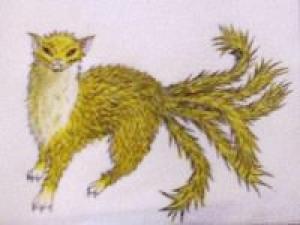
About Loren Coleman
Loren Coleman is one of the world’s leading cryptozoologists, some say “the” leading living cryptozoologist. Certainly, he is acknowledged as the current living American researcher and writer who has most popularized cryptozoology in the late 20th and early 21st centuries.
Starting his fieldwork and investigations in 1960, after traveling and trekking extensively in pursuit of cryptozoological mysteries, Coleman began writing to share his experiences in 1969. An honorary member of Ivan T. Sanderson’s Society for the Investigation of the Unexplained in the 1970s, Coleman has been bestowed with similar honorary memberships of the North Idaho College Cryptozoology Club in 1983, and in subsequent years, that of the British Columbia Scientific Cryptozoology Club, CryptoSafari International, and other international organizations. He was also a Life Member and Benefactor of the International Society of Cryptozoology (now-defunct).
Loren Coleman’s daily blog, as a member of the Cryptomundo Team, served as an ongoing avenue of communication for the ever-growing body of cryptozoo news from 2005 through 2013. He returned as an infrequent contributor beginning Halloween week of 2015.
Coleman is the founder in 2003, and current director of the International Cryptozoology Museum in Portland, Maine.










that reminds me of Nintails from that Japanese Pokemon Cartoon. It’s a Fox with nine tails.. Sometimes i wonder if the drawer/creator of pokemon seen unknown animals and drew them as pokemon or at least saw unknown animals and drew them and changed their looks a bit… you never know actually. i read that japanese has the strangest animals. maybe it’s true…..
Another round of applause for another informative and enjoyable installment on Japan’s cryptological natural history. Thanks again, mystery man. As an indicator of your considerable talent at bringing these unknown creatures into the light, rather than being somewhat disappointed to discover they aren’t probably magical but natural, I’m left with a pronounced desire to go into my local forest and hedgerows and see them for myself using the age old technique of applying patience, while sitting quietly, with my senses keyed-in. It seems every aspect of nature, plant and animal, with which I become acquainted using those old standbys (and some good luck) I become privy to some mystery. Cheers.
PS..Just out of curiosity, I imagine that the cryptological/supernatural menagerie of the lands adjacent to Japan must also be inhabited by fantasticals naturally and otherwise. How does Japan’s account of cryptids compare to Korea’s?
Bear in mind that in Japanese folklore, the fox, the badger, and other animals often appear in human form, and many of the most disturbing interactions with them were when they APPEARED human. It would be consistent with the legends for the raiju to still be around, but unrecognized.
I wonder if the “multiple tails” of the raiju are just a description of forked lightning. Or maybe they’re a misinterpretation of some artistic representation of an animal that is waving its tail violently.
Great follow-up, Brent.
You’ve outshone yourself in research and knowledge, as always.
Personally I tend to think the Raiju are extinct. But that’s me.
I must say that I’m quite pleased that those who have commented so far seem to have enjoyed this. I am happy to be bringing these mysteries of the far east here for your perusal and enjoyment.
Dogu4- Patience, quiet, and a little luck, the key weapons in any good naturalist’s arsenal. Your way of looking at things mirrors my own. I have had the pleasure of observing all of the creatures mentioned here on many occasions and it never ceases to fascinate me. Although the animals may be described here as “mundane” in relation to thunder beasts, there is nothing mundane about them really. They are fabulous. I hope you will go out, sit quietly, and see the mysteries that nature holds right in front of our noses.
As to your question about the mysteries adjacent to Japan. Korea does have some mysteries similar to Japan. For instance, the cryptid snake Tsuchinoko is said to inhabit the mountains of Korea, and some of the folkloric entities resemble Japanese yokai (mythical monsters and ghosts), some of which could be based on the cryptozoological. Perhaps even more than Korea, China has some very interesting similarities with Japan in its fantastic beasts. For instance, China has its own creature reminiscent of Japan’s bird-man Tengu, and Chinese mermaids are similar to Japanese ones in some respects. There are other folkloric animals with possible cryptozoological connections as well. China even has its own version of these thunder beasts I’ve been talking about here. A lot of this is very likely due to the cultural influence China had on Japan.
Fhqwhgads- I wonder about the multiple tails too. Interestingly, this feature is not mentioned in all accounts of these creatures, and were not included in descriptions of the captured specimens. I wonder if it was due to certain instances of violent tail waving, or even a completely fabricated detail.
cryptidsrus- Thank you for your kind words. They are much appreciated. I’m glad I’ve gotten you to thinking about what these creatures were, and whether they are extinct or whatever the case may be.
I’ll try to keep bringing these mysteries to the attention of you and the other fine readers of Cryptomundo.
This is a great piece! Thank you, it was extremely interesting!!
Great followup as usual. Keep it coming.
Ah man… I’m a sucker for mustelids (have been since I kept ferrets as a kid). That marten is an absolutely beautiful critter.
Thanks again for these great articles.
Does anyone known of similar creatures described elsewhere in Asia, or would the Raiju be unique to Japan?
Great job, as usual.
You exemplify to me the way a scientist ought to look at the natural world. Wonder is OK, guys and gals! It surprises me how often scientists seem to forget what brought them to science in the first place. It doesn’t help science, not a whit, when that happens. It becomes doubly unfortunate when I reflect that scientists may be tamping down the wonder quotient because of a public that has forgotten how to properly entertain it as well.
Were it not for unknown possibilities, the concept of “the advancement of science” would be inconceivable. I like the way you embrace those.
DWA- Thank you. For me those are words of high praise indeed. I appreciate it greatly.
In response to DJ Plasmic Nebula, there was actually a pokemon called Raichu which was a “thunder rodent” type and was said to ride lightning. But it is true that Nintails did look like the images they were showing. I find it fascinating how traditions and myths such as these are incorporated into modern outlets and completely overlooked by the general population.